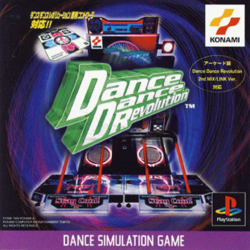- Dance Dance Revolution (1998 video game)
-
"Dance Dance Revolution (video game)" redirects here. For other uses, see Dance Dance Revolution (disambiguation).
Dance Dance Revolution 
Artwork for the first console port of DDR as part of Konami's Dance Simulation Games.Developer(s) Konami Computer Entertainment Tokyo Publisher(s) Konami Computer Entertainment Tokyo, Konami of America, Konami of Europe GmbH Distributor(s) Konami Computer Entertainment Tokyo, Konami of America, Konami of Europe GmbH Series Dance Dance Revolution, Bemani Engine Custom Platform(s) Arcade, Sony PlayStation Release date(s) Arcade: - Asia March 1999
- PAL March 1999
Arcade re-release:
PlayStation:
Genre(s) Music, Exercise Mode(s) Single-player, Multiplayer Rating(s) Arcade: - AAMA: Suitable for All Ages
PlayStation:
- CERO: A
Media/distribution CD (1) Cabinet Custom Arcade system Bemani System 573 Analog[4] CPU R3000A 32 bit RISC processor (33.8 MHz)[4] Sound PlayStation SPU[4] Display 29" CRT (Raster, 256x224 & 740x480)[4] Dance Dance Revolution, abbreviated DDR, is a game that was released in arcades by Konami on November 21, 1998 in Japan. DDR is a unique music video game involving dance and rhythm that defined the genre. The game involves timing and balance by having players use their feet instead of their hands like typical video games. In March 1999, the game was released to the Asian and North American arcade audiences. It was also released to the European arcade audience under the name Dancing Stage. Players and game critics were caught off-guard by the game's addictive qualities winning the new franchise many merits to its design.
On April 10, 1999, Dance Dance Revolution was released on the Japanese PlayStation, adding new music and gameplay elements. A console release was not made for any other region. Despite the global popularity of DDR the series remained obscure outside of Japan and few official additional arcade releases of DDR were made elsewhere until the multi-regional release of Dance Dance Revolution SuperNova in 2006.
Contents
Development
Gameplay
Main article: Gameplay of Dance Dance RevolutionThe general premise of Dance Dance Revolution is to move one's feet to a set pattern. One player can play using one dance pad (Single mode), two players can play using one dance pad each (Versus mode), or one player can play using both dance pads (Doubles mode).
Players must step to the beat, matching their beat to the arrows presented to them on screen by stepping on arrows on a dance stage. A judgment is displayed for each step, depending on the player's timing; Perfect!!, Great!, Good, Boo or Miss.... An on-screen life meter, known as the Dance Gauge, begins halfway full at the start of each song. Perfect and Great steps slowly fill the Gauge, while Boo and Miss steps quickly deplete it. Good steps have no effect either way. If players accumulates too many Boos or Misses, and the Dance Gauge becomes empty, the song fails and the game ends.
Players may play anywhere from one to five songs, depending on how many the arcade operator sets the machine to play each game. At the end of each song, players see their accumulated points, bonus points, and how many of each kind of step they made. They also get a letter grade that is dependent on the judgments received during play, ranging from SS, all steps Perfect, to E, failure, which is only seen in Versus mode when the other player passes. If players manage to pass their songs a cumulative results screen is given, totaling the stats from all played stages.
Interface and graphics
The song selection interface of Dance Dance Revolution is a jukebox-like menu of CDs that represent the available songs. On this screen, various step codes can be entered on the dance stage to modify the arrangement and appearance of arrows during gameplay. On the arcade version of Dance Dance Revolution step codes must be entered to switch between difficulty levels.
During gameplay, 3D dancing characters appear in the background of each song. Different characters can be selected at the main title screen by standing on either the left or right arrow panels while pressing the select button.
Hardware
Home Version
The home version was released in Japan on April 10, 1999 for Sony PlayStation. It includes all 11 songs from the original arcade version along with 5 new songs, three of which are from the arcade version of Dance Dance Revolution 2ndMIX and the rest being console-exclusive songs (which would be added in DDR 2ndMIX Link Version) for a total of 16 songs. It also includes Edit Mode (for editing stepcharts) and Arrange Mode (a mode where if the player step on direction the arrows not meant to appear, they will get a miss).
Music
Main article: Music of Dance Dance Revolution (1998 video game)Soundtrack
Main article: Dance Dance Revolution 2ndMix Original SoundtrackThe 1st mix songs are in DDR 2nd mix soundtrack.
Reception
A success of the game are begin in 1998 and 1999 with a dancing stage and the motion of the screen.
Credits
References
- ^ NekoNeko. "Dance Dance Revolution Internet Ranking Version for Arcade" (in Japanese). DDRers' Stompin' Ground. Archived from the original on 2010-04-10. http://www.webcitation.org/5orko52fI. Retrieved 2010-04-10.
- ^ NekoNeko. "Dancing Stage for Arcade (PAL)" (in Japanese). DDRers' Stompin' Ground. Archived from the original on 2010-04-10. http://www.webcitation.org/5orlUAyy5. Retrieved 2010-04-10.
- ^ NekoNeko. "Dance Dance Revolution for Play Station" (in Japanese). DDRers' Stompin' Ground. Archived from the original on 2010-04-10. http://www.webcitation.org/5orlJXfoX. Retrieved 2010-04-10.
- ^ a b c d Broyad, Toby. "BEMANI SYSTEM 573 ANALOG HARDWARE". System 16 The Arcade Museum. Archived from the original on 2010-04-10. http://www.webcitation.org/5ork0VEio. Retrieved 2010-04-10.
External links
- Dance Dance Revolution official website (Japanese)
- Dancemania (Japanese)
Preceded by
nothingDance Dance Revolution
1998Succeeded by
Dance Dance Revolution 2ndMixCategories:- 1998 video games
- Arcade games
- Dance Dance Revolution games
- PlayStation-only games
- Video games developed in Japan
Wikimedia Foundation. 2010.
